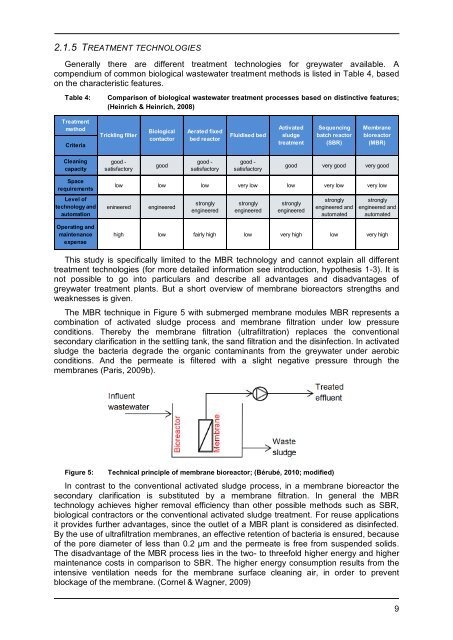An innovative greywater treatment system for urban areas ... - SuSanA
An innovative greywater treatment system for urban areas ... - SuSanA
An innovative greywater treatment system for urban areas ... - SuSanA
Create successful ePaper yourself
Turn your PDF publications into a flip-book with our unique Google optimized e-Paper software.
2.1.5 TREATMENT TECHNOLOGIES<br />
Generally there are different <strong>treatment</strong> technologies <strong>for</strong> <strong>greywater</strong> available. A<br />
compendium of common biological wastewater <strong>treatment</strong> methods is listed in Table 4, based<br />
on the characteristic features.<br />
Table 4: Comparison of biological wastewater <strong>treatment</strong> processes based on distinctive features;<br />
(Heinrich & Heinrich, 2008)<br />
Treatment<br />
method<br />
Criteria<br />
Cleaning<br />
capacity<br />
Space<br />
requirements<br />
Level of<br />
technology and<br />
automation<br />
Operating and<br />
maintenance<br />
expense<br />
Trickling filter<br />
good -<br />
satisfactory<br />
Biological<br />
contactor<br />
good<br />
good -<br />
satisfactory<br />
good -<br />
satisfactory<br />
This study is specifically limited to the MBR technology and cannot explain all different<br />
<strong>treatment</strong> technologies (<strong>for</strong> more detailed in<strong>for</strong>mation see introduction, hypothesis 1-3). It is<br />
not possible to go into particulars and describe all advantages and disadvantages of<br />
<strong>greywater</strong> <strong>treatment</strong> plants. But a short overview of membrane bioreactors strengths and<br />
weaknesses is given.<br />
The MBR technique in Figure 5 with submerged membrane modules MBR represents a<br />
combination of activated sludge process and membrane filtration under low pressure<br />
conditions. Thereby the membrane filtration (ultrafiltration) replaces the conventional<br />
secondary clarification in the settling tank, the sand filtration and the disinfection. In activated<br />
sludge the bacteria degrade the organic contaminants from the <strong>greywater</strong> under aerobic<br />
conditions. <strong>An</strong>d the permeate is filtered with a slight negative pressure through the<br />
membranes (Paris, 2009b).<br />
Figure 5: Technical principle of membrane bioreactor; (Bérubé, 2010; modified)<br />
good very good very good<br />
low low low very low low very low very low<br />
enineered engineered<br />
Aerated fixed<br />
bed reactor<br />
strongly<br />
engineered<br />
Fluidised bed<br />
strongly<br />
engineered<br />
Activated<br />
sludge<br />
<strong>treatment</strong><br />
strongly<br />
engineered<br />
Sequencing<br />
batch reactor<br />
(SBR)<br />
strongly<br />
engineered and<br />
automated<br />
Membrane<br />
bioreactor<br />
(MBR)<br />
strongly<br />
engineered and<br />
automated<br />
high low fairly high low very high low very high<br />
In contrast to the conventional activated sludge process, in a membrane bioreactor the<br />
secondary clarification is substituted by a membrane filtration. In general the MBR<br />
technology achieves higher removal efficiency than other possible methods such as SBR,<br />
biological contractors or the conventional activated sludge <strong>treatment</strong>. For reuse applications<br />
it provides further advantages, since the outlet of a MBR plant is considered as disinfected.<br />
By the use of ultrafiltration membranes, an effective retention of bacteria is ensured, because<br />
of the pore diameter of less than 0.2 µm and the permeate is free from suspended solids.<br />
The disadvantage of the MBR process lies in the two- to threefold higher energy and higher<br />
maintenance costs in comparison to SBR. The higher energy consumption results from the<br />
intensive ventilation needs <strong>for</strong> the membrane surface cleaning air, in order to prevent<br />
blockage of the membrane. (Cornel & Wagner, 2009)<br />
9

















